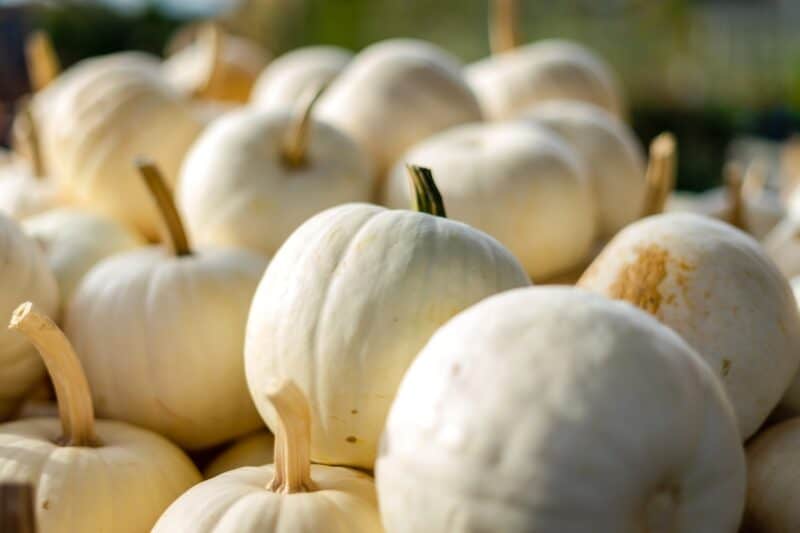When you think of a pumpkin, you probably immediately think of the classic orange variety. But did you know that white pumpkins exist, too?

It’s true: that white, pumpkin-looking squash is not some special variety of squash, it’s just a white pumpkin!
Sometimes what you see really I what you get, but this begs the question: Are white pumpkins white inside, too?
Some are, most aren’t. White pumpkins are usually not white inside. Although the outside of a white pumpkin may appear white, ivory-colored, or speckled, the interior color is usually just orange. A few varieties have pale yellow or near-white flesh, though.
This is sure to be a disappointment for people who were planning an innovatively-colored pumpkin pie, but that is just the way it is.
You’ll have to settle for the usual color after all. There is plenty more to learn about white pumpkins, though, and we will tell you all about it below.
What Determines the Color of a Pumpkin?
A pumpkin’s color palette is determined by genetics. Each type or cultivar of pumpkin has its own characteristic genes that determine its color.
This genetic trait can be expressed differently depending on environmental conditions and soil nutrition.
If a pumpkin’s natural environment lacks adequate amounts of certain minerals or nutrients, then the colors may not be as pronounced as they would otherwise be.
Some varieties of pumpkins are specifically bred to create different colors (and shapes for that matter).
For instance, the Knucklehead variety is bred to produce bumps and ridges on the outside of the fruit. This gives them an interesting appearance when compared to more traditional types of pumpkins.
Similarly, the Cotton Candy pumpkin was developed through selective breeding to produce an extra sweet and flavorful bright white pumpkin.
Of course, the use of chemicals or paint can also affect the color of pumpkins, but no one willingly does that unless they are making Halloween decorations!
Why are White Pumpkins White?
White pumpkins get their color because they lack carotenoids. Carotenoid molecules are fat-soluble compounds that can be found in most plants.
They act as powerful antioxidants, protecting cells from damage caused by environmental stressors such as ultraviolet radiation. They also give produce its vivid colors by absorbing specific wavelengths of light.
It is carotenoids that are responsible for colors like orange, yellow and red in many types of fruits and vegetables, and that certainly includes pumpkins.
In most varieties of pumpkins, the production of carotenoids is high enough to make their skin appear orange or yellow in color.
But in the case of white pumpkins, the lack of carotenoids is what contributes to the pumpkin’s pale outer hue. However, most types produce enough carotenoids that they still have orange or at least yellow-tinted flesh.
In short, white pumpkins aren’t white because they have a certain pigment, but are instead white because they lack it.
Are White Pumpkins Edible?
Yes! White pumpkins are edible just as regular orange pumpkins! The taste and texture of white pumpkins can be quite different than that of their orange counterparts, though.
White pumpkins tend to have a milder flavor, their flesh is usually less sweet. Some taste bitter.
Some white pumpkin cultivars are also known for having a thick skin and bland flesh, meaning they are almost totally unsuited for eating.
Are All Kinds of White Pumpkins Safe to Eat?
Yes, all commonly cultivated white pumpkin varieties are safe to eat. However, it is still important to check for signs of rot or disease before consuming any pumpkin.
White pumpkins can be susceptible to certain fungal diseases, so always inspect the fruit carefully before using it in recipes.
How Nutritious are White Pumpkins?
There is not much validated scientific data on the exact nutrient composition of white pumpkins, but we can make some educated guesses based on what is known about their orange relatives.
White pumpkins are likely to contain many of the same vitamins and minerals found in regular pumpkins, including vitamins A and C, beta-carotene, potassium, iron, and fiber.
They may also be a source of other beneficial compounds like antioxidants and polyphenols. Despite the pale color, white pumpkins are still a wholesome and nutritious addition to the diet.
Can You Eat White Pumpkin Seeds, Too?
Yes, you sure can. White pumpkin seeds are just as edible and nutritious as those from traditional pumpkins.
In fact, white pumpkin seeds are often said to have a milder flavor than regular pumpkin seeds and a few are renowned for sweetness and a nice crisp crunch, like the Casper variety.
If you’re looking for a unique spin on your snacking experience, then definitely save those white pumpkin seeds.
Can You Use White Pumpkins in Recipes?
Absolutely, and there are many cultivars that are highly popular in various pumpkin dishes: pumpkin pie, bread, soup, you name it.
If you’d like to give white pumpkins a try in the kitchen, look for the Baby Boo, Lumina, Polar Bear, Cotton Candy, or Valenciano varieties. All are known for tender flesh, sweetness, and suitability for baking and cooking.
Can Animals Eat White Pumpkins?
Yes. Pumpkins are generally safe for animals, including white pumpkins. Most mammals- cats, dogs, rats, squirrels, etc.- can eat them with no issues, seeds and all.
You can provide your furry friends with a special treat by whipping up something for them using any fresh surplus white pumpkins you have.
However, for our pets raw pumpkins should be avoided since they can be difficult to digest.
Once cooked or pureed, however, pumpkins can be an excellent source of fiber and other important nutrients for animals.
Concerning nutrition, white pumpkins are just as good for animals as their orange counterparts.
Tom has lived and worked on farms and homesteads from the Carolinas to Kentucky and beyond. He is passionate about helping people prepare for tough times by embracing lifestyles of self-sufficiency.
